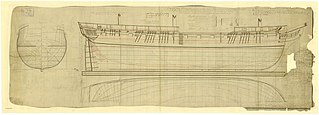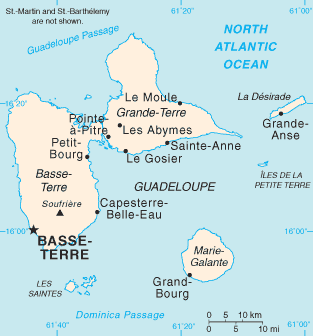
HMS Java was a British Royal Navy 38-gun fifth-rate frigate. She was originally laid down in 1805 as Renommée, described as a 40-gun Pallas-class French Navy frigate, but the vessel actually carried 46 guns. The British captured her in 1811 in a noteworthy action during the Battle of Tamatave, but she is most famous for her defeat on 29 December 1812 in a three-hour single-ship action against USS Constitution. Java had a complement of about 277, but during her engagement with Constitution she allegedly had 426 aboard, in comparison with her opponent's 475.

HMS Astraea was a 32-gun fifth rate Active-class frigate of the Royal Navy. Fabian at E. Cowes launched her in 1781, and she saw action in the American War of Independence as well as during the Napoleonic Wars. She is best known for her capture of the larger French frigate Gloire in a battle on 10 April 1795, while under the command of Captain Lord Henry Paulet. She was wrecked on 23 March 1808 off the coast of Anegada in the British Virgin Islands.

HMS Phoebe was a 36-gun fifth rate of the Royal Navy. She had a career of almost twenty years and fought in the French Revolutionary Wars, the Napoleonic Wars and the War of 1812. Overall, her crews were awarded six clasps to the Naval General Service Medals, with two taking place in the French Revolutionary Wars, three during the Napoleonic Wars and the sixth in the War of 1812. Three of the clasps carried the name Phoebe. During her career, Phoebe sailed to the Mediterranean and Baltic seas, the Indian Ocean, South East Asia, North and South America.
Captain Sir Charles Marsh Schomberg was an officer of the British Royal Navy, who served during French Revolutionary and Napoleonic Wars, and later served as Lieutenant-Governor of Dominica.

Étoile was a 44-gun frigate of the French Navy, launched in 1813. The British captured her in 1814 and the Royal Navy took her into service as HMS Topaze. She did not go to sea again until 1818, and was paid off in 1822. She served as a receiving ship until 1850 and was broken up in 1851.

HMS Galatea was an Apollo-class fifth rate of the Royal Navy. The frigate was built at Deptford Dockyard, London, England and launched on 31 August 1810. In 1811 she participated in the Battle of Tamatave, which battle confirmed British dominance of the seas east of the Cape of Good Hope for the rest of the Napoleonic Wars. She was hulked in 1836 and broken up in 1849.

The Mauritius campaign of 1809–1811 was a series of amphibious operations and naval actions fought to determine possession of the French Indian Ocean territories of Isle de France and Île Bonaparte during the Napoleonic Wars. The campaign lasted from the spring of 1809 until the spring of 1811, and saw both the Royal Navy and the French Navy deploy substantial frigate squadrons with the intention of disrupting or protecting trade from British India. In a war in which the Royal Navy was almost universally dominant at sea, the campaign is especially notable for the local superiority enjoyed by the French Navy in the autumn of 1810 following the British disaster at the Battle of Grand Port, the most significant defeat for the Royal Navy in the entire conflict. After their victory, the British used the original Dutch name of Mauritius for Isle de France. In 1814, Île Bonaparte was returned to France, who eventually renamed it La Réunion.

HMS Iphigenia was a Royal Navy 36-gun Perseverance-class fifth-rate frigate. She was built at Chatham Dockyard by Master Shipwright Robert Seppings.

Néréide was a Sibylle-class, 32-gun, copper-hulled frigate of the French Navy. On 22 December 1797 HMS Phoebe captured her and she was taken into British service as HMS Nereide. The French recaptured her at the Battle of Grand Port, only to lose her again when the British took Isle de France, in 1810. After the Battle of Grand Port she was in such a poor condition that she was laid up and sold for breaking up in 1816.

The Battle of Tamatave was fought off Tamatave in Madagascar between British and French frigate squadrons during the Napoleonic Wars. The action was the final engagement of the Mauritius campaign of 1809–1811, and it saw the destruction of the last French attempt to reinforce their garrison on Mauritius. Although the news had not reached Europe by February 1811 when the reinforcement squadron left Brest, Mauritius had been captured in December 1810 by a British invasion fleet, the French defences hampered by the lack of the supplies and troops carried aboard the frigate squadron under the command of Commodore François Roquebert in Renommée. Roquebert's heavily laden ships reached Mauritius on 6 May and discovered that the island was in British hands the following day, narrowly escaping a trap laid by a squadron of British frigates ordered to hunt and destroy them.
The Junon was a Gloire class 40-gun frigate of the French Navy. Launched in 1806, she saw service during the Napoleonic Wars, escorting merchant convoys to France's besieged Caribbean colonies. In February 1809 she was captured at sea after a fierce engagement with four Royal Navy vessels.

HMS Nisus was a Royal Navy 38-gun fifth rate frigate, launched in 1810 at Plymouth, named for Virgil's character Nisus from The Aeneid.

HMS Eclipse was a Royal Navy Cruizer-class brig-sloop built by John King at Dover and launched in 1807. She served off Portugal and then in the Indian Ocean at the capture of the Île de France. Shortly thereafter she captured Tamatave. She was sold for mercantile service in 1815. She traded with India until 1823. Then between 1823 and 1845 she made seven voyages as a whaler.

HMS Racehorse was a Royal Navy 18-gun Cruizer-class brig-sloop built by Hamilton & Breeds and launched in 1806 at Hastings. She served in the English Channel, where she captured a small privateer, and in the East Indies, where she participated in the capture of Isle de France and the operations around it. She was wrecked in 1822.

Roquebert's expedition to the Caribbean, was an unsuccessful operation by a French naval squadron to transport supplies to Guadeloupe in December 1809 at the height of the Napoleonic Wars. Over the previous year, British Royal Navy squadrons had isolated and defeated the French Caribbean colonies one by one, until by the autumn Guadeloupe was the only colony remaining in French hands. Cut off from the rest of the world by British blockade squadrons that intercepted all ships coming to or from the island, Guadeloupe was in a desperate situation, facing economic collapse, food shortages and social upheaval, as well as the impending threat of British invasion. In an effort to reinforce and resupply the colony, the French government sent four vessels to the West Indies in November 1809 under Commodore François Roquebert. Two of the ships were 20-gun flûtes carrying supplies and troops. The two others were 40-gun frigates, ordered to protect the storeships on their journey from the British forces operating off both the French and Guadeloupe coasts.

The Blockade of Saint-Domingue was a naval campaign fought during the first months of the Napoleonic Wars in which a series of British Royal Navy squadrons blockaded the French-held ports of Cap Français and Môle-Saint-Nicolas on the northern coast of the French colony of Saint-Domingue, soon to become Haiti, after the conclusion of the Haitian Revolution on 1 January 1804. In the summer of 1803, when war broke out between the United Kingdom and the French Consulate, Saint-Domingue had been almost completely overrun by Haitian forces commanded by Jean-Jacques Dessalines. In the north of the country, the French forces were isolated in the two large ports of Cap Français and Môle-Saint-Nicolas and a few smaller settlements, all supplied by a French naval force based primarily at Cap Français.

The Battle of Jobourg was a minor naval engagement between British and French frigate squadrons during the last weeks of the War of the Sixth Coalition in the 22nd and penultimate year of the French Revolutionary and Napoleonic Wars. In October 1813 the French Navy, unable to challenge the Royal Navy's dominance at sea, sent two small squadrons of frigates to harass British trade in the Atlantic Ocean. One was brought to battle in January 1814 and defeated near the Canary Islands but the second, from Nantes and consisting of the frigates Etoile and Sultane, fought an inconclusive engagement against British frigate HMS Severn on 4 January in the mid-Atlantic and a furious battle against HMS Astrea and HMS Creole on 23 January near Maio in the Cape Verde Islands.
Jean-François Lemaresquier was a French naval officer.
Captain Woodley Francis Losack was an officer of the British Royal Navy, who served during the French Revolutionary Wars and the Napoleonic Wars. He participated in the Battle of Tamatave (1811) as captain of HMS Galatea.
Admiral Kenelm Somerville, 17th Lord Somerville was a Royal Navy officer and Scottish hereditary peer. He joined the navy in 1801 and served throughout the Napoleonic Wars, fighting at the invasion of Isle de France, Battle of Tamatave, and invasion of Java. He was promoted to commander in 1811 and in 1813 took command of the troopship HMS Thames which he sailed to North America to fight in the War of 1812. Promoted to post-captain in 1814, he commanded a flotilla in the expedition that burned Washington. Somerville retired from the navy in 1846 and continued to be promoted on the retired list, becoming an admiral in 1862. He inherited the title of Lord Somerville from his brother in 1842 and died at Newbold Comyn in 1864 at the age of 76.














